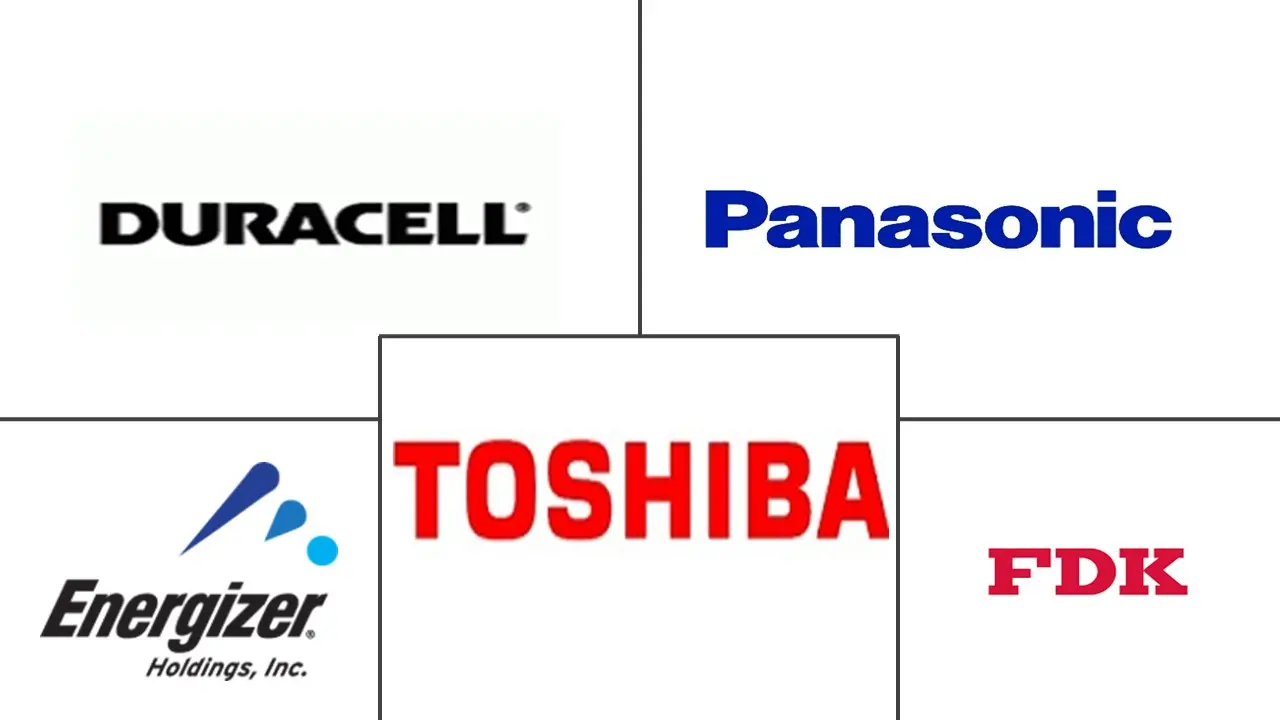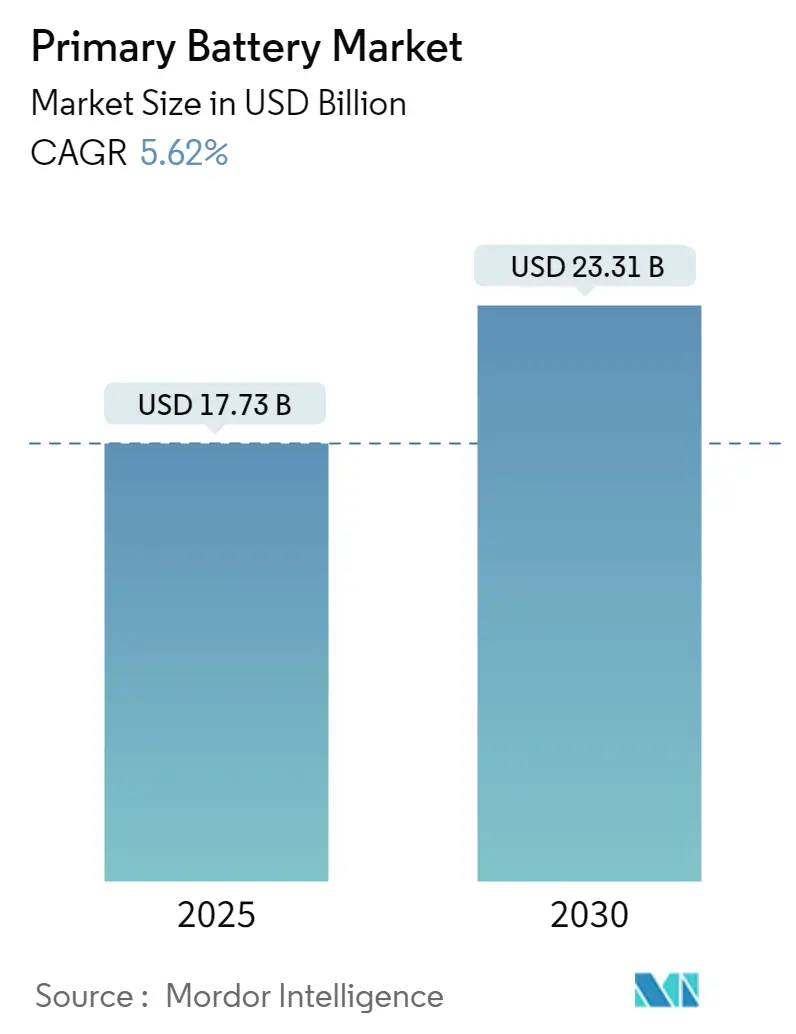
Primary Battery Market Analysis by Mordor Intelligence
The Primary Battery Market size is estimated at USD 17.73 billion in 2025, and is expected to reach USD 23.31 billion by 2030, at a CAGR of 5.62% during the forecast period (2025-2030).
The primary battery industry continues to evolve amid changing technological landscapes and end-user requirements, with a particular focus on enhanced performance and specialized applications. The defense sector remains a crucial market driver, as evidenced by Germany's landmark EUR 100 billion defense investment commitment in 2022, followed by Poland's announcement to increase its defense budget from 2% to 3% of GDP from 2024 onwards. These developments have significantly boosted the demand for military-grade primary batteries used in critical applications such as communication devices, night-vision equipment, and tactical gear. The industry has also witnessed substantial innovations in battery chemistry and design to meet the stringent requirements of modern military battery applications.
The healthcare sector has emerged as a significant growth catalyst for the primary battery market, driven by the increasing adoption of portable medical devices and diagnostic equipment. According to the Canadian Institute of Health Information, healthcare spending amounted to approximately 12.7% of Canada's GDP in 2021, with medical equipment expenditure accounting for roughly 3% of the annual healthcare spending. The industry has seen a notable shift toward miniaturized medical devices and implantable medical equipment, which require reliable, long-lasting medical device batteries with specific voltage and capacity requirements. Manufacturers have responded by developing specialized batteries with enhanced safety features and longer shelf life to meet these demanding healthcare applications.
The integration of Internet of Things (IoT) devices and smart technologies has created new opportunities for primary battery manufacturers, particularly in low-power, long-life applications. The market has witnessed increased demand for disposable batteries in smart meters, sensors, and monitoring devices, where reliable, maintenance-free power sources are essential. This trend is particularly evident in industrial and commercial applications, where battery-powered IoT devices are deployed in remote or hard-to-reach locations. Manufacturers have focused on developing portable batteries with improved energy density and extended operational life to meet these emerging requirements.
The industry's supply chain dynamics have undergone significant transformation, with manufacturers emphasizing regional production capabilities and supply chain resilience. According to recent trade data, the United States witnessed a substantial increase in primary battery imports, reaching USD 8.27 billion in 2021, marking a 71.01% increase compared to the previous year. This trend has prompted manufacturers to reevaluate their production strategies and invest in local manufacturing capabilities to reduce dependency on imports. Additionally, the industry has seen increased focus on sustainable manufacturing practices and environmentally responsible disposal methods, with several countries implementing stricter regulations regarding battery recycling and disposal.
Global Primary Battery Market Trends and Insights
Growing Consumer Electronics Usage
The increasing penetration of consumer electronic devices continues to be a primary driver for the primary battery market, particularly alkaline batteries, which are essential for low-drain applications like remote controls, clocks, and portable entertainment devices. In China alone, television penetration reached approximately 119 sets per hundred households in 2021, indicating the massive installed base of devices requiring primary consumer batteries for basic functions. This widespread adoption of consumer electronics is further supported by rising disposable incomes, with China's purchasing power parity per capita reaching USD 21,475.6 in 2022, enabling greater consumer spending on electronic devices and their power sources.
The robust growth of the electronics manufacturing sector, particularly in Asia-Pacific, has created sustained demand for primary disposable batteries. Japan's electronics industry achieved a total production value of USD 77.93 billion in 2022, with consumer electronics equipment accounting for approximately USD 2.6 billion. The continued innovation in portable electronic devices, combined with the preference for primary batteries in low-drain applications due to their cost-effectiveness and reliability, ensures steady market growth. Primary alkaline batteries remain particularly popular due to their long shelf life of up to 10 years and stable voltage output, making them ideal for consistent performance in consumer devices.
Rising Medical Device Adoption
The healthcare sector's increasing reliance on portable medical devices has emerged as a significant driver for the primary battery market, particularly in devices like glucose monitors, blood pressure monitors, and other diagnostic equipment. The demand is amplified by the growing aging population across developed nations and the shift toward home healthcare solutions, which require reliable and long-lasting power sources. Primary batteries, especially lithium-based variants, are preferred in medical devices due to their high energy density, stable voltage output, and proven safety record in critical applications.
The trend toward digitalization in healthcare systems and the adoption of portable medical equipment has created sustained demand for primary batteries. These batteries are essential for devices that require consistent power output and cannot risk power interruptions, making them crucial for patient monitoring and diagnostic equipment. The preference for primary batteries in medical applications is further strengthened by their long shelf life and reliability, which is critical for emergency medical equipment and devices that may not be used frequently but must work without fail when needed. The demand for medical device batteries is thus expected to grow in tandem with these trends.
Increasing Military/Defense Applications
The defense sector's growing reliance on portable electronic equipment and communication devices has become a substantial driver for the primary battery market. Military applications require batteries that can perform reliably in extreme conditions and provide consistent power output for critical operations. Primary batteries, particularly lithium-based variants, are preferred in military applications due to their high energy density, extended shelf life, and ability to operate in extreme temperatures, making them ideal for tactical equipment, night vision devices, and portable communication systems.
The continuous modernization of military forces worldwide and the increasing adoption of advanced portable equipment have created sustained demand for high-performance primary batteries. These batteries are essential for powering crucial military equipment such as GPS devices, tactical radios, and night vision goggles, where reliability and performance are paramount. The preference for primary batteries in military applications is further reinforced by their proven track record in harsh environments and their ability to maintain stable voltage output throughout their discharge cycle, ensuring consistent performance of critical equipment during operations.
Environmental Benefits
The environmental advantages of modern primary batteries have become a significant market driver, particularly as manufacturers have successfully eliminated mercury from their products while maintaining performance standards. Contemporary primary alkaline batteries are environmentally friendly and can be disposed of as regular waste, eliminating the need for specialized recycling processes that are required for other battery types. This simplification of disposal procedures has made primary batteries more attractive to both consumers and institutional users who are increasingly conscious of environmental compliance requirements.
The development of mercury-free batteries by major manufacturers has addressed historical environmental concerns while maintaining performance standards. These advancements have positioned primary batteries as an environmentally responsible choice, particularly in applications where battery replacement is infrequent. The ability to dispose of these batteries as regular waste, combined with their compliance with various environmental regulations and standards, has made them increasingly attractive to environmentally conscious consumers and organizations. This environmental benefit is particularly significant when compared to rechargeable batteries, which require specific collection and recycling procedures, making primary batteries a more convenient option for many applications.
Segment Analysis: Type
Primary Alkaline Battery Segment in Primary Battery Market
The alkaline battery segment has established itself as the dominant force in the global primary battery market, commanding approximately 44% of the total market share in 2024. This segment's leadership position is driven by its widespread application across consumer electronics, remote controls, toys, flashlights, and various portable devices. The segment's success can be attributed to the optimal balance of cost-effectiveness, reliability, and performance characteristics that alkaline batteries offer compared to other primary battery types. These batteries are particularly favored in low to moderate drain applications where consistent voltage delivery and reasonable shelf life are crucial. The segment's growth is further supported by the increasing demand from emerging markets and the continuous expansion of battery-powered consumer devices. Additionally, technological advancements in alkaline battery manufacturing have led to improved performance characteristics and longer shelf life, further strengthening their market position.
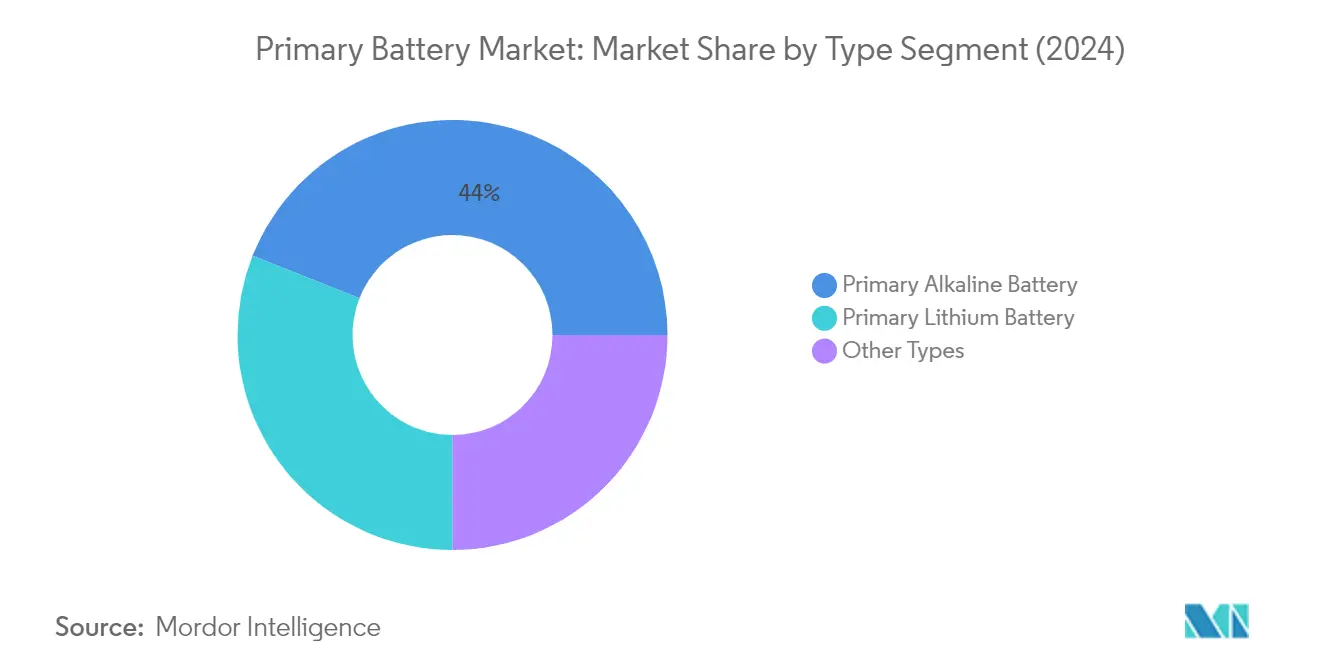
Remaining Segments in Primary Battery Market
The lithium primary battery segment represents a significant portion of the market, offering high energy density and superior performance in specialized applications such as medical devices, military equipment, and professional electronics. These batteries are particularly valued for their long shelf life, reliability in extreme conditions, and ability to provide stable voltage output throughout their discharge cycle. The Other Types segment, which includes zinc-carbon batteries and other chemistries, continues to serve specific niche markets where cost considerations outweigh performance requirements. While these alternative battery types may face increasing competition from rechargeable solutions, they maintain their relevance in specific applications where their unique characteristics provide distinct advantages, particularly as a disposable battery option.
Primary Battery Market Geography Segment Analysis
Primary Battery Market in North America
North America represents a mature and technologically advanced primary battery market, holding approximately 13% of the global market share in 2024. The region's market is primarily driven by high consumer electronics adoption, advanced healthcare infrastructure, and significant military battery market applications. The United States leads the regional market, characterized by robust research and development activities in battery technology and stringent quality standards. The market benefits from the region's strong focus on portable medical devices, emergency backup systems, and specialized military equipment. Consumer awareness regarding battery efficiency and environmental impact has led to increased demand for high-performance primary batteries in specific applications where they offer advantages over rechargeable alternatives. The region's retail infrastructure and e-commerce penetration have ensured widespread availability of primary batteries across various distribution channels. Additionally, the presence of major manufacturers and their extensive distribution networks has contributed to market stability and consistent product innovation.
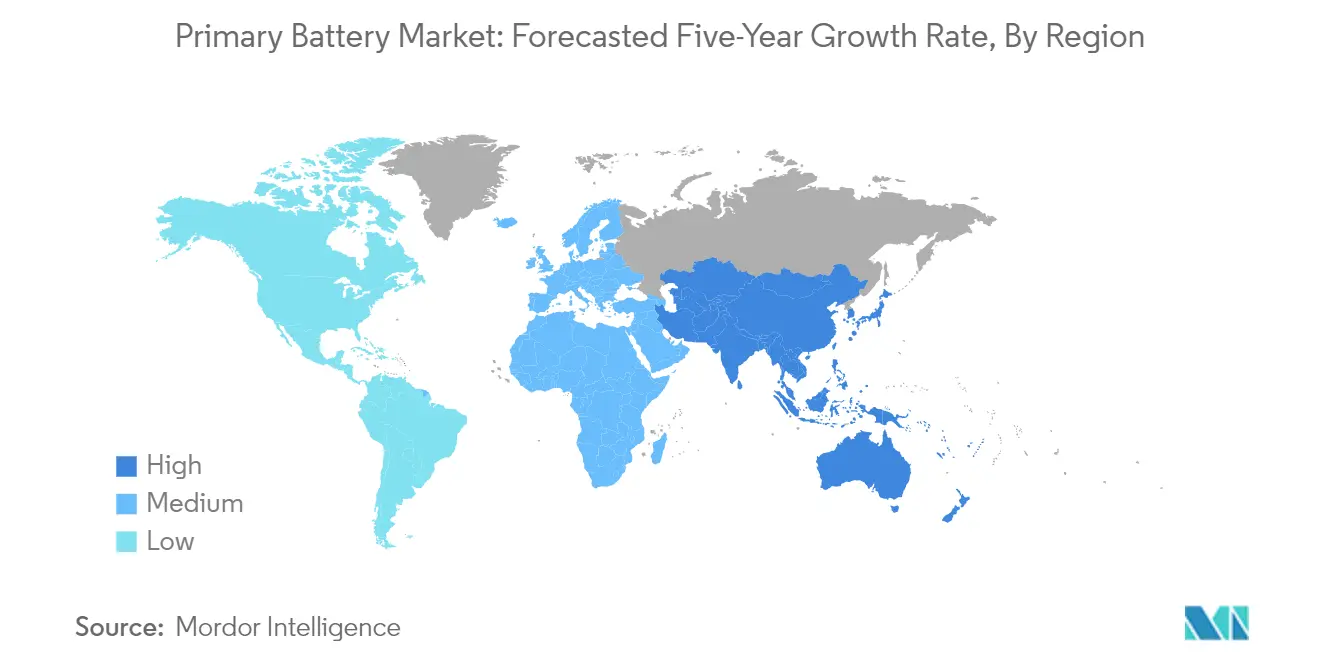
Primary Battery Market in Europe
The European primary battery market has demonstrated steady growth, recording approximately 5% annual growth from 2019 to 2024, driven by increasing demand from both consumer and industrial sectors. The region's market is characterized by strict regulatory frameworks, particularly regarding battery disposal and recycling requirements. European consumers show a strong preference for high-quality, long-lasting primary batteries, especially in applications where reliability is crucial. The market benefits from advanced healthcare systems and growing adoption of portable medical devices across the region. Industrial applications, including measurement instruments and emergency systems, continue to drive demand for specialized primary batteries. The region's focus on sustainability has led to innovations in battery technology and recycling processes. Market dynamics are influenced by the strong presence of established manufacturers and a growing emphasis on energy-efficient solutions. The region's robust distribution infrastructure and increasing e-commerce penetration have enhanced product accessibility across different market segments.
Primary Battery Market in Asia-Pacific
The Asia-Pacific primary battery market is positioned for robust expansion, with projections indicating approximately 11% annual growth from 2024 to 2029. The region represents the largest manufacturing hub for primary batteries globally, with China leading in production capabilities. Market dynamics are shaped by rapid industrialization, increasing urbanization, and growing consumer electronics adoption across developing economies. The region's diverse market landscape encompasses both mature markets like Japan and South Korea, and emerging markets like India and Southeast Asian countries. Manufacturing advantages, including cost-effective production and availability of raw materials, continue to attract global manufacturers to establish facilities in the region. The market benefits from continuous technological advancements and increasing investments in research and development. Growing healthcare infrastructure and rising disposable incomes are driving demand for portable medical devices and consumer electronics, subsequently boosting primary battery consumption.
Primary Battery Market in South America
The South American primary battery market demonstrates significant potential for growth, driven by increasing urbanization and rising consumer electronics adoption. Brazil and Argentina represent the largest markets in the region, with expanding middle-class populations contributing to increased demand. The market is characterized by a strong preference for cost-effective solutions, particularly in consumer applications. Distribution networks continue to evolve, with e-commerce platforms gaining significance in product accessibility. The region's industrial sector, particularly in mining and telecommunications, creates steady demand for specialized primary batteries. Market dynamics are influenced by local manufacturing initiatives and import policies across different countries. The healthcare sector's modernization and increasing adoption of portable medical devices are creating new opportunities for market expansion. Consumer awareness regarding battery quality and performance is gradually increasing, leading to shifting preferences toward branded products.
Primary Battery Market in Middle East & Africa
The Middle East and Africa primary battery market exhibits diverse characteristics across different sub-regions, with the Middle East showing advanced market maturity while African markets present emerging opportunities. The region's market is driven by increasing infrastructure development, growing consumer electronics penetration, and expanding healthcare facilities. Oil and gas industries in the Middle East create significant demand for specialized primary batteries in various applications. The African market shows potential for growth due to increasing electrification efforts and rising consumer purchasing power in urban areas. Market dynamics are influenced by a combination of imported products and growing local manufacturing initiatives. The healthcare sector's modernization across both regions is creating new demand channels for primary batteries. Distribution networks are evolving, particularly in urban centers, improving product accessibility. The market benefits from increasing investments in industrial and commercial sectors, particularly in Gulf Cooperation Council countries.
Competitive Landscape
Top Companies in Primary Battery Market
The primary battery market features several established global players, including Energizer Holdings, Panasonic Corporation, Toshiba Corporation, FDK Corporation, and Saft Groupe SA. These companies are heavily investing in research and development to enhance battery performance, reliability, and cost competitiveness while addressing environmental concerns. Operational agility is demonstrated through strategic restructuring initiatives, with companies creating dedicated battery divisions to ensure focused management and innovation. Market leaders are pursuing strategic collaborations and acquisitions to strengthen their technological capabilities and expand their geographical presence. Companies are also emphasizing sustainable development by introducing environmentally friendly battery products and solutions, while simultaneously working on improving manufacturing efficiency and supply chain optimization to maintain a competitive advantage.
Consolidated Market Led By Global Conglomerates
The primary battery market exhibits a relatively consolidated structure dominated by large multinational conglomerates with diverse product portfolios spanning multiple industries. These established players leverage their extensive manufacturing capabilities, robust distribution networks, and strong brand recognition to maintain market leadership. The market is characterized by significant barriers to entry due to high capital requirements, technological expertise needs, and stringent regulatory compliance standards. Regional players maintain a presence in specific geographical markets through specialized product offerings and local market knowledge.
The industry has witnessed notable merger and acquisition activities aimed at portfolio expansion and technological advancement. Companies are actively pursuing strategic acquisitions to strengthen their market position and gain access to new technologies and markets. Recent transactions include Reliance Industries' acquisition of Lithium Werks BV, Ultralife Corporation's purchase of Excell Battery Group, and Eco-Bat Technologies' acquisition of Emrol, demonstrating the industry's consolidation trends and companies' focus on expanding their technological capabilities and geographical footprint through inorganic growth strategies.
Innovation and Sustainability Drive Future Success
Success in the alkaline battery industry and dry cell battery industry increasingly depends on companies' ability to innovate while maintaining cost competitiveness and environmental responsibility. Market incumbents need to focus on developing advanced battery technologies that offer improved performance characteristics while meeting evolving environmental regulations. Companies must invest in research and development to create differentiated products, optimize manufacturing processes, and establish strong partnerships across the value chain. Additionally, developing robust distribution networks and maintaining strong relationships with key customers across various end-use sectors is crucial for maintaining market share.
For new entrants and smaller players, success lies in identifying and serving specific market niches with specialized products or applications. Companies need to carefully evaluate the threat from substitute products, particularly rechargeable batteries, and develop strategies to maintain market relevance. Building strategic partnerships with technology providers and establishing efficient supply chain networks can help contenders gain ground against established players. Furthermore, companies must stay ahead of evolving regulatory requirements, particularly regarding environmental sustainability and safety standards, while maintaining operational efficiency to compete effectively in the market. The consumer battery and military battery industry sectors are also pivotal areas where innovation and sustainability can drive future growth.
Primary Battery Industry Leaders
-
Duracell Inc.
-
FDK Corporation
-
Panasonic Corporation
-
Toshiba Corporation
-
Energizer Holdings Inc.
- *Disclaimer: Major Players sorted in no particular order
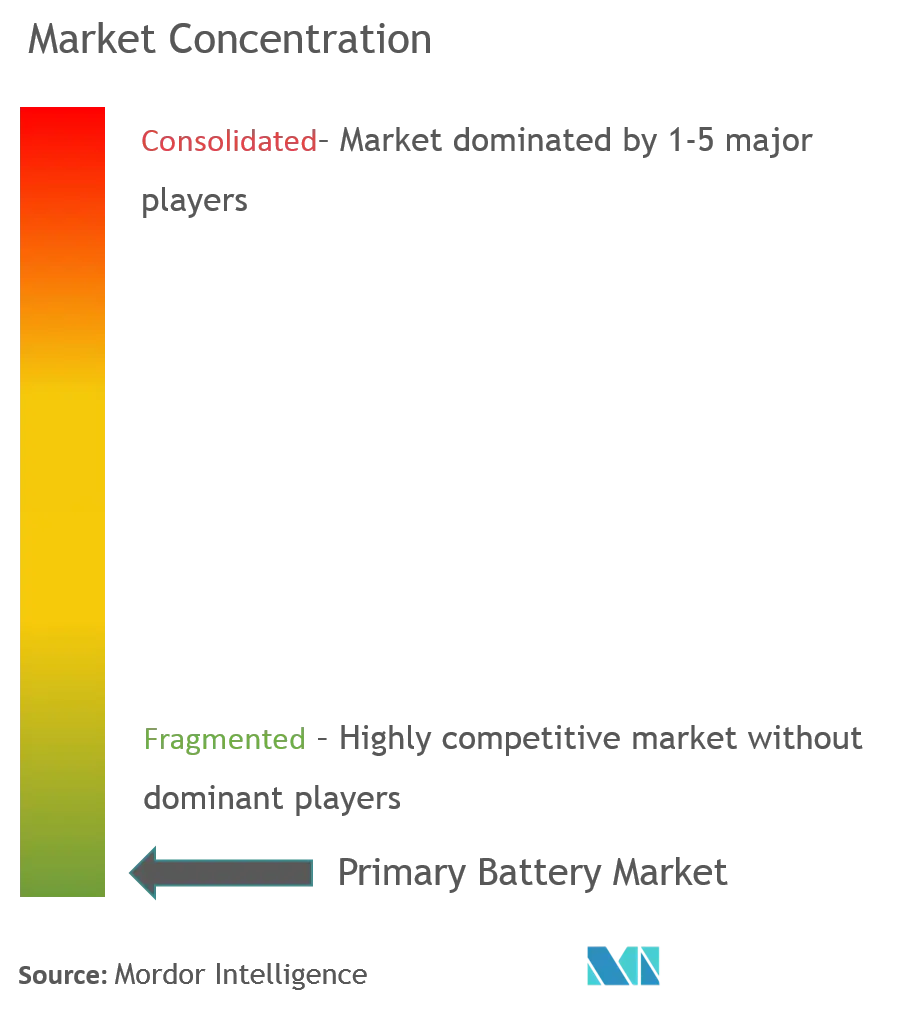
Recent Industry Developments
- September 2023, in accordance with Prime Minister Narendra Modi's ambitious initiative 'Mission LiFE' (Lifestyle for Environment), the Technology Development Board (TDB) revealed its partnership with Aloe Ecell Pvt Ltd, an innovative startup based in Lucknow, Uttar Pradesh.
- November 2022: Researchers at MIT have invented new ways to improve the energy density of non-rechargeable or primary batteries. This invention is expected to enable up to a 50% increase in extending lifetime or a corresponding decrease in size and weight for a given power or energy capacity. The new materials work at human body temperature, making them suitable for medical implants.
- March 2022: FDK Corporation announced the consolidation of domestic production plants to strengthen its production system for high-capacity cylindrical-type primary lithium battery production plants into a single location. FDK will terminate production at Washizu Plant and consolidate the production plant at Tottori Plant. The production facilities operations were expected to restart at the Tottori Plant by the end of 2022 after the relocation.
Global Primary Battery Market Report Scope
Primary batteries refer to portable batteries designed to be used once and discarded. Primary batteries are non-rechargeable as the electrochemical reactions in the cell are irreversible.
The primary battery market is segmented by type and geography. By type, the market is segmented into primary alkaline battery, primary lithium battery, and other types. The report also covers market size and forecasts for the primary battery market across major regions. The market sizing and forecasts have been projected in revenue (USD) for each segment.
| Primary Alkaline Battery |
| Primary Lithium Battery |
| Other Types |
| North America | United States |
| Canada | |
| Rest of North America | |
| Europe | Germany |
| France | |
| United Kingdom | |
| Russia | |
| Rest of Europe | |
| Asia-Pacific | China |
| Japan | |
| Thailand | |
| Indonesia | |
| Malaysia | |
| India | |
| Rest of Asia-Pacific | |
| South America | Brazil |
| Argentina | |
| Rest of South America | |
| Middle East and Africa | Saudi Arabia |
| United Arab Emirates | |
| South Africa | |
| Rest of Middle East and Africa |
| Type | Primary Alkaline Battery | |
| Primary Lithium Battery | ||
| Other Types | ||
| Geography | North America | United States |
| Canada | ||
| Rest of North America | ||
| Europe | Germany | |
| France | ||
| United Kingdom | ||
| Russia | ||
| Rest of Europe | ||
| Asia-Pacific | China | |
| Japan | ||
| Thailand | ||
| Indonesia | ||
| Malaysia | ||
| India | ||
| Rest of Asia-Pacific | ||
| South America | Brazil | |
| Argentina | ||
| Rest of South America | ||
| Middle East and Africa | Saudi Arabia | |
| United Arab Emirates | ||
| South Africa | ||
| Rest of Middle East and Africa | ||
Key Questions Answered in the Report
How big is the Primary Battery Market?
The Primary Battery Market size is expected to reach USD 17.73 billion in 2025 and grow at a CAGR of 5.62% to reach USD 23.31 billion by 2030.
What is the current Primary Battery Market size?
In 2025, the Primary Battery Market size is expected to reach USD 17.73 billion.
Who are the key players in Primary Battery Market?
Duracell Inc., FDK Corporation, Panasonic Corporation, Toshiba Corporation and Energizer Holdings Inc. are the major companies operating in the Primary Battery Market.
Which is the fastest growing region in Primary Battery Market?
Asia-Pacific is estimated to grow at the highest CAGR over the forecast period (2025-2030).
Which region has the biggest share in Primary Battery Market?
In 2025, the Asia-Pacific accounts for the largest market share in Primary Battery Market.
What years does this Primary Battery Market cover, and what was the market size in 2024?
In 2024, the Primary Battery Market size was estimated at USD 16.73 billion. The report covers the Primary Battery Market historical market size for years: 2020, 2021, 2022, 2023 and 2024. The report also forecasts the Primary Battery Market size for years: 2025, 2026, 2027, 2028, 2029 and 2030.
Page last updated on:
